The File Explorer
When certain file types are imported into Data Prep Studio, a file explorer displays. This explorer will help you further define the data to be added to your workspace.
For example, if your data source is a Microsoft Access file containing three tables, you would use the Access Options dialog to select which of these three tables should be added to your workspace. If you decide to use a different table from the same data source at a later time, you would use the same explorer to discard the old table and select a new one.
The file explorer launches when you:
- Add data sources such as HTML, JSON, Microsoft Access, Microsoft Excel, or XML files to a workspace
- Select Load Options in the Column Information panel of the Preview window
- Right click on a table in the Prepare window and select Edit Table Info or Edit Load Options.
The tables below describe the various options available in these explorers. Where available, clicking on the Refresh ![]() button in an explorer will give you an updated view of your table with all changes applied. This functionality will help ensure that the data you wish to work with are correctly selected before they are brought into your workspace.
button in an explorer will give you an updated view of your table with all changes applied. This functionality will help ensure that the data you wish to work with are correctly selected before they are brought into your workspace.
Microsoft Access Data Sources

|
Field |
Description |
|
Table |
Specifies which table in the Access file to load into the workspace. |
For Microsoft Excel Data Sources
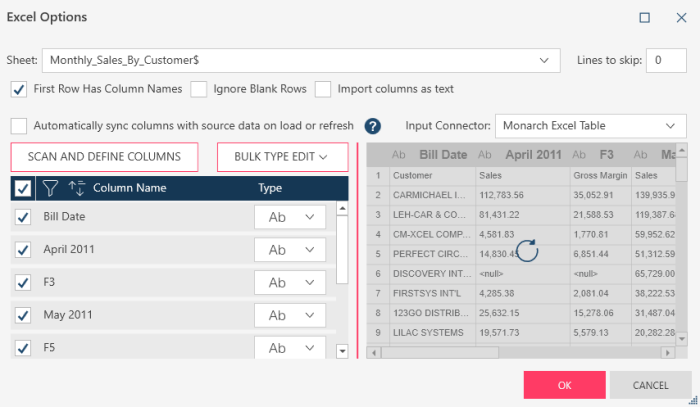
|
Field |
Description |
|
Sheet |
Specifies the name of the sheet to load into the workspace. |
|
Lines to skip |
Specifies the number of rows to skip, starting from the first line, if these lines do not contain data. |
|
First Row Has Column Names |
When selected, indicates that the first row of the sheet includes the column names. |
|
Ignore Blank Rows |
When selected, instructs the application to ignore blank rows and load the table without these rows. |
|
Import columns as Text |
When selected, instructs the application to import all columns with the data type text regardless of the original data type. |
|
Automatically sync columns with source data on load or refresh |
When selected, instructs the application to sync the columns of the loaded table with the columns of the source table upon load or refresh. This functionality is useful in instances where the columns in your source table change over time. Note that when this mode is applied, your Change History items may yield an error state if the columns the sync is applied to are renamed or deleted from the source file. |
|
Input Connector |
Specifies the connector type (i.e., Monarch Excel Table or Monarch ACE OLE DB (Legacy) to apply when the table is loaded. |
|
Scan and Define Columns |
When selected, instructs the application to return data types to their original values (as determined by the Monarch Excel Table connector). This option is deactivated if the input connector is Monarch ACE OLE DB (Legacy) or Automatically sync columns with source data on load or refresh is selected. |
|
Bulk Type Edit |
Specifies a single ("bulk") data type to apply to all fields in your data source. This option is deactivated if the input connector is Monarch ACE OLE DB (Legacy) or Automatically sync columns with source data on load or refresh is selected. NOTE: Specific data types can be assigned to each of the columns in your Excel data source using the Type drop-down lists provided to the right of each column. |
HTML Data Sources
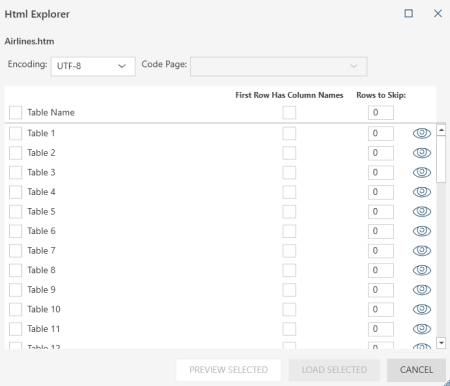
|
Field |
Description |
|
First Row Has Column Names |
When selected, indicates that the first row of the sheet includes the column names. |
|
Lines to skip |
Specifies the number of rows to skip, starting from the first line, if these lines do not contain data. |
For Delimited Text Files
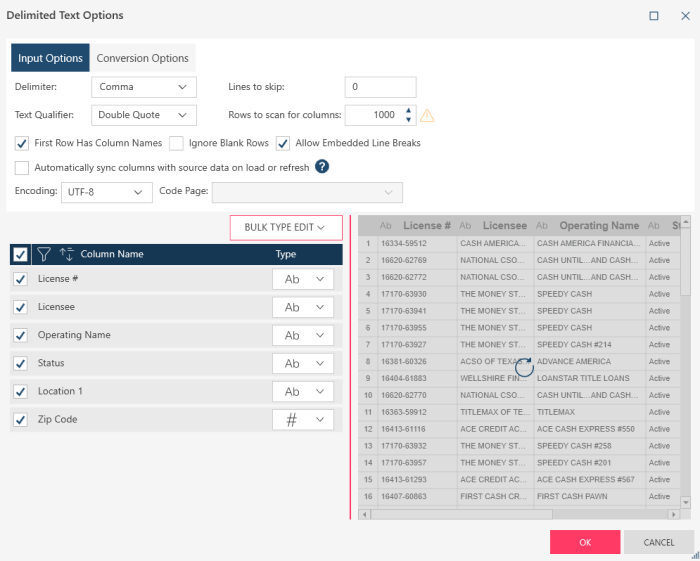
|
Field |
Description |
|
INPUT OPTIONS |
|
|
Delimiter |
Specifies the type of delimiter used to separate fields in a delimited text file. The most common delimiters are:
If the delimiter you are looking for is not on this list (e.g., ^), simply type it into the field. |
|
Lines to skip |
Specifies the number of rows to skip, starting from the first line, if these lines do not contain data. |
|
Text Qualifier |
Specifies the text qualifier used to mark the start and end of a column entry. The most common text qualifiers are:
|
|
Rows to scan for columns |
Specify how many rows to scan in your data source before Data Prep Studio decides on a data type for the column. Note that setting this number to a very high value may negatively impact the application's load performance depending on the number of rows and columns in your input source. |
|
First Row Has Column Names |
When selected, indicates that the first row of the sheet includes the column names. |
|
Ignore Blank Rows |
When selected, instructs the application to ignore blank rows and load the table without these rows. |
|
Allow Embedded Line Breaks |
When selected, instructs the application to preserve embedded line breaks when importing columns. |
|
Automatically sync columns with source data on load or refresh |
When selected, instructs the application to sync the columns of the loaded table with the columns of the source table upon load or refresh. This functionality is useful in instances where the columns in your source table change over time. Note that when this mode is applied, your Change History items may yield an error state if the columns the sync is applied to are renamed or deleted from the source file. |
|
Encoding |
Specifies the encoding type to apply when loading the table into your workspace. The encoding types enabled for delimited-text files include:
|
|
Code Page |
When the Encoding type selected is Code page, this setting instructs the application to apply the selected code page to the table upon loading into your workspace. |
|
Bulk Type Edit |
Specifies a single ("bulk") data type to apply to all fields in your data source. NOTE: Specific data types can be assigned for each of the columns in your delimited text file data source using the Type drop-down lists provided to the right of each column. This option is deactivated if Automatically sync columns with source data on load or refresh is selected. |
|
CONVERSION OPTIONS |
|
|
From text to numeric |
Decimal Separator - Specifies the character to use as a decimal separator when converting text into a numeric value. You can select:
|
|
From text to date |
Date Format - Specifies the format of dates used when converting text into a date value. You can select:
First Year of Century - Specifies the first year of the century (100-year range) to use when converting two-digit years into four-digit years. The default value is 50 (i.e., 1950-2049). Extraction Pattern - Specifies the pattern applied to a text string when converted into a date/time value. You can select:
|
For XML Data Sources
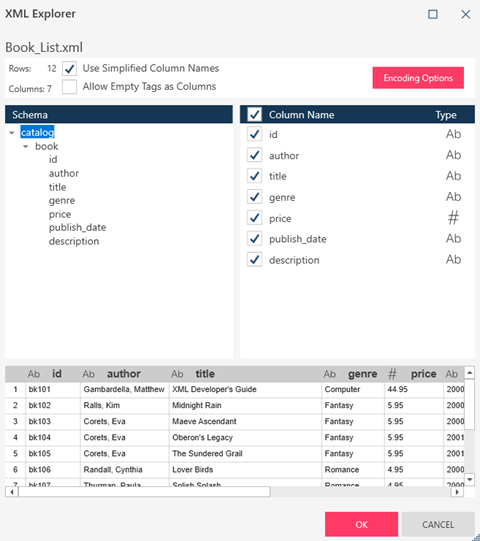
|
Field |
Description |
|
Use Simplified Columns Names |
When selected, instructs the application to open the XML table using simplified column names as column headers. |
|
Allow Empty Tags as Columns |
When selected, this setting instructs the application to allow the import of XML elements with no values as columns. This setting applies for both self-closing (e.g., <Name/>) and conventionally tagged (e.g., <Name></Name>) elements. |
| Encoding Options |
Specifies the encoding type to apply when loading the table into your workspace. The encoding types enabled for XML files include:
|
For JSON Data Sources
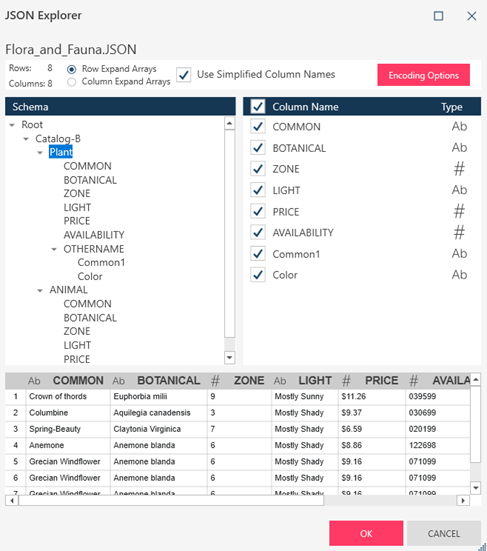
|
Field |
Description |
| Row Expand Arrays | When selected, instructs the application to transform an array of objects, where each object represents a row with potentially nested arrays, into a more normalized table structure where each element within those nested arrays becomes its own row. |
| Column Expand Arrays | When selected, instructs the application to transform an array of objects, where each object represents a row with potentially nested arrays, into a more table structure where each element within those nested arrays becomes its own column. |
|
Use Simplified Columns Names |
When selected, instructs the application to open the JSON table using simplified column names as column headers. |
| Encoding Options |
Specifies the encoding type to apply when loading the table into your workspace. The encoding types enabled for JSON files include:
|
© 2025 Altair Engineering Inc. All Rights Reserved.